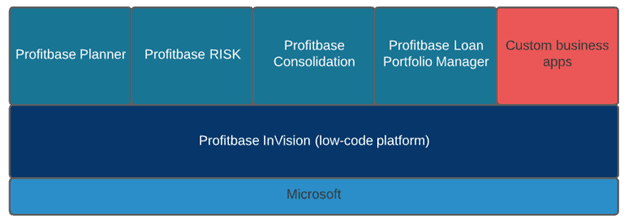
Companies are benefitting from a flexible EPM suite using a low-code platform.
Profitbase has delivered software solutions for financial planning and analysis (FP&A) for more than 30 years, with products such as Dia, Sim, and WebPlan.
Although these were excellent tools for budgeting, forecasting, and simulation, they were not built to solve other business challenges and processes such as resource planning, production management, customer relationship management (CRM), financial close and consolidation, risk, master data management, and so on.
This was not unique to Profitbase, as most enterprise performance management (EPM) software is built to solve one thing and solve it well. However, this requires businesses to invest in many software systems to handle different processes and requirements across the organization.
From a technical perspective, we know this adds complexity and costs because the systems need to be integrated to exchange information. From a user’s perspective, it reduces efficiency because users need to switch between multiple systems to get their job done.
Why build our own low-code platform?
When we built our new EPM platform, we aimed to build a system so flexible that it could solve a vast range of business challenges and processes across an organization and across industries, yet keep the implementation cost a minimum.
Considering the various challenges and requirements businesses have, this might sound hard or even impossible to achieve, but as one of our engineers said: “It all boils down to differences in terminology, user interfaces, and the orchestration of passing data around.”
We wanted to give our customers a unified platform that could help them add value at every organizational level.
How are we doing it?
To facilitate these requirements, we split our development efforts into two areas: a technical platform and business solution development.
Doing it this way ensures we can have strong business domain experts working on business solutions without relying on engineers. Meanwhile, the engineers can solve the technical challenges rather than learning all the business requirements for different industries and domains.
The technical platform is our low-code application development platform called Profitbase InVision. This platform has all the technical building blocks to create and run various business applications and processes.
Low-code development enables enterprises to rapidly build and deploy software applications without using professional software developers.
Instead of writing every single line of code for a given application, low-code platform users can build their solutions with drag-and-drop interfaces and little to no coding.
How do you benefit from a low-code platform?
The Profitbase Planner, Risk, Consolidation, and Loan Portfolio Manager are built on top of Profitbase InVision. When you get any of these business solutions, you also get the low-code platform.
This means you can easily customize or extend any Profitbase business solution or create custom add-ons that are unique to your business. Tailormade add-ons enable you to:
- Save hours of time to focus on other projects, making your business leaner and more agile
- Reduce manual work and speed up the software development process
- Lower IT costs for future development
We often see customers use our low-code platform to create extensions for replacing Excel-based workflows or processes that are either too costly or hard to handle in their ERP systems.
Many customers also use Profitbase InVision as a standalone platform to create unique, custom applications that are not related to standard Profitbase FP&A solutions.

A low-code platform reduces costs, improving flexibility and efficiency.
Summary
To sum things up, the main benefit you get from how we build and deliver our solutions is great flexibility through access to the low-code platform. However, although you have the power to customize just about everything, this does not mean you always should.
Our business solutions are a result of years spent working closely with many customers and partners across diverse industries to create products that follow best practices and work processes.
Talk to us and consider what you need to customize, and what should be left as is.








